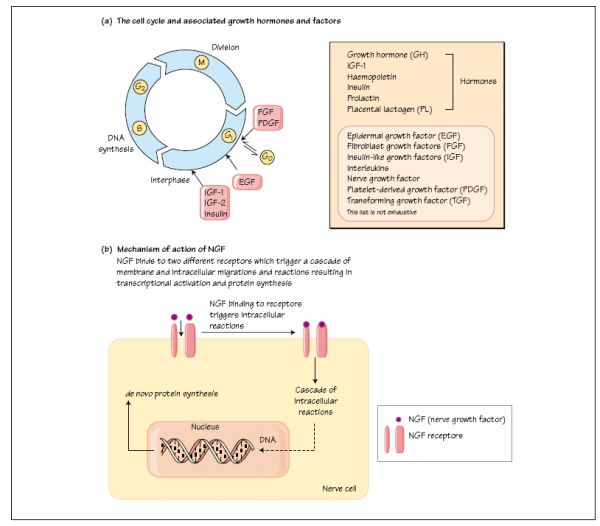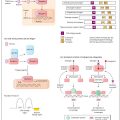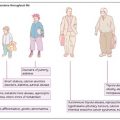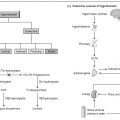
Tumours secreting IGF- 1 and IGF- 2 have been described in humans. They are very rare! The tumours are part of the group of neuroendocrine tumours, the most common of which are carcinoids. Patients with neuroendocrine tumours may present with severe hypoglycaemic episodes and confirmed hypoglycaemia in non-diabetic patients should always be investigated. The primary tumour may be difficult to localize and the patient requires specialist treatment from a multidisciplinary team of endocrinologists, surgeons, radiologists and oncologists.
Cellular growth and proliferation
The cell cycle
The growth phase is G1, which prepares the cell for the synthetic phase S, during which the DNA becomes duplicated (Fig. 9a). The cell splits into two daughter cells in the M phase. The new cells may thereafter remain in G0 (e.g. neurones, muscle cells), or enter G1 to repeat the cycle. Tumour cells may remain in G0, before re-entering G1. Growth factors and hormones act at specific phases of the cell cycle.
Growth factors
Insulin-like growth factors (IGF-1, IGF-2). IGF-1 and IGF-2 mediate the actions of growth hormone and have other important metabolic effects. GH causes the release of IGF-1 and IGF-2 from the liver, although IGF-1 is the most GH dependent. Both circulate in plasma bound to proteins known as IGF- binding proteins (IGF-BPs), of which six specific types have been described. Cellular responses to IGF are mediated by specific IGF receptors, which are similar to but distinct from insulin receptors. Plasma levels of IGF- 1 and IGF- 2 remain fairly constant in the healthy adult due to the stability of their binding proteins. IGF-1 mRNA can be detected in numerous body tissues and is thought to play a GH-independent role in tissue growth. Its production is stimulated by insulin and the hyperinsulinaemia of obesity may affect circulating IGF-1 and IGF-BP concentrations.
Insulin. Apart from its role in the control of carbohydrate metabolism, insulin is an anabolic hormone. Without insulin, protein catabolism is enhanced and amino acid uptake into muscle is inhibited, as is the translation of mRNA.
Placental lactogen (PL)
Stay updated, free articles. Join our Telegram channel

Full access? Get Clinical Tree








